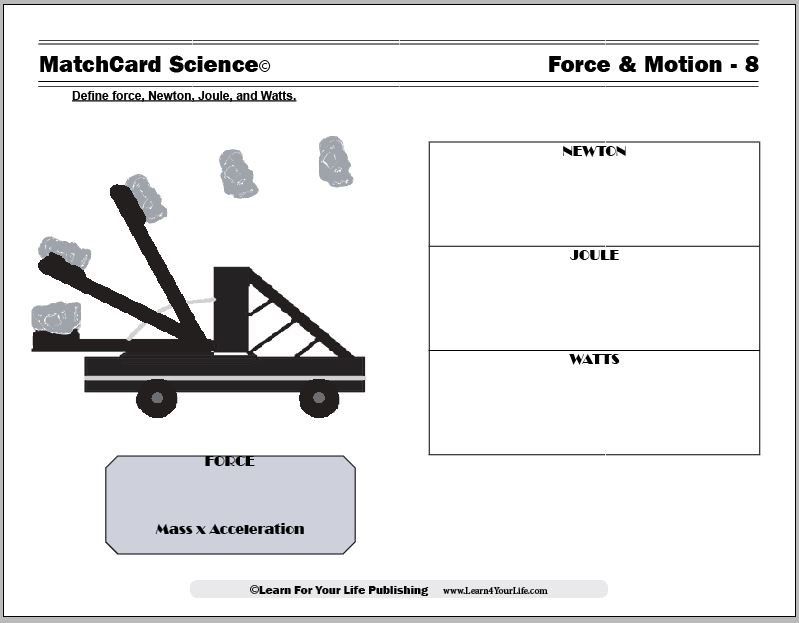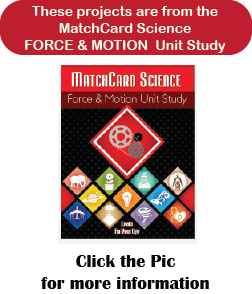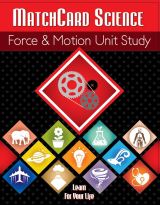Newtons Joules Watts
Let's Study Newtons, Joules, and Watts
This Force and Motion MatchCard defines force, Newtons, Joule, and Watts for 3rd to 8th graders.
Free Download Below


The Newtons, Joules, Watts MatchCard
Objective: Define force, Newton, Joule, and Watts.MatchCard: Download below.
MatchCard Information Pieces define each of the four terms (force, Newton, Joule, Watts) and gives the mathematical formula.
Projects: Build a catapult and check out your electric bill.
Download and Use the Newtons-Joules-Watts MatchCard


This is MatchCard #8 of the Force and Motion Unit Study. You can find more information on MatchCard Science below.
Newtons: Defintion and Activities
In the first session we review force, learn about newtons, and engage in some newtonian inspired activities.Quick Review of Force
We learned in MatchCard 6 that acceleration is the change of speed and is measured in meters per second per second. (Also written m/s2.)We learned in MatchCard 7 that Newton’s 2nd law states force is necessary for an object to start moving. Force is calculated by multiplying mass x acceleration.
Today we are going to put those two lessons together and examine force more closely.
Force: Push or Pull
Force is the push or pull on an object. Have you ever tried to move something without using a push or pull motion? Even if you try to move something by blowing on it, it is a force.What Is A Newton?
We measure force in a unit called newtons. (Now just who do you think that’s named after?) The abbreviation for newton is a capital N. One newton is the amount of force required to accelerate one kilogram object to one meter per second squared. It is written like this:1 N = (kg(m)/s2
How Much Force Is One Newton?
Of course, like any measaurement, you can have more than one. So if you threw a 2 kilogram object so fast it accelerated to 3 meters per second squared you would have exerted a force of 6 newtons or 6 N. Wow, do you think that would be a lot? I mean, could you become a major league baseball player with that kind of force? Let’s do the next project and see.Placee a Newton cookie (which, by the way, was apparently named after the town Newton, Massachussets which was founded 12 years before Isaac was born) on a table. Push it across the table, at about the rate of one meter in one second.
The force you used was approximately one newton. Of course, our measurement is not exact; but it gives you an idea of 1 N.
So, um, sorry; you’re not likely to make the big time in baseball or football with a 6 N throw.
40 newtons is the force of a big kick of a soccer ball (the professionals can do double that.) 2000 newtons might break your bones. The take home point is that newton is a push or pull force that can accelerate an object.
Another 1 Newton Demonstration
Stack 7 Newton cookies in your hand. Close your eyes and feel them pushing into your hand. That is one newton also.Hmmm, where is the acceleration? Gravity is a force remember, and it has an acceleration of 9.8 m/s2. So anything with a mass of 100 grams will exert a gravitational force of 1 Newton. 100 grams is the mass of objects with about 3.5 ounces or 0.22 pounds. If you don’t believe me, you can do the math yourself. (Force = m x a.) Don’t forget 100 grams is 0.1 kg.
The One Newton Game
You will need a small scale (ounces or grams) or a spring scale that measures Newtons or 100 grams. You can also use a blind fold if you are inclined to cheat when you are supposed to close your eyes. Try to apply 1 Newton of pressure to the scale. Remember, that would be 100 grams, or about 3.5 ounces or 0.22 pounds. You can have a blind competition and see who gets closest.Another Newton Game
As you go about the tasks of cleaning your room, playing a game, or making dinner, notice all the times you exert force (either push or pull.) Say “Newton” whenever you notice a force in action. You can even estimate how many newtons you think it is.MatchCards
Find the Information Pieces for force and newton and place them on the MatchCard.Joules: Defintion and Activities
Students need to understand force and newtons in order to understand joules.Introductory Activity
Have one student hold a heavy stack of books (or suitcase, bag of groceries, laundry detergent or something heavy.) The other student can carry a small book across the room, or roll a light weight object. If there is only one student, do each task individually.So who did the most work? Actually, the person who pushed the light weight object. According to a physicist, work is movement accomplished by a force. So a two year old riding his tricycle is doing more work than a muscle man holding hundreds of pounds of weight. (Don’t tell them that while they are holding it, though.)
Work vs Force
Just because effort is exerted doesn’t mean work was done. Clinch your teeth, squeeze your fist, pound your fist into a tree trunk: no movement, no work. (But according to Newton’s law there will be a reaction to your action. Your fist will feel it if you strike the tree.)Definition of Joule
We measure work done in joules which is abbreviated with a capital J. One joule is the amount of work done when one newton of force moves an object one meter. We can write this one of two ways.1 J = 1 N x 1 m
Do you remember how much one newton is? (1 kg x 1 m/s2.) Therefore if you substitute the original units for the newton you get:1 J = (kg(m2)/s2
How Much Is One Joule?
Move your newton cookie again and make sure you move it exactly one meter in as close to one second as you can. Congratulations: you got one joule of work done.Your heart does LOTS of work, contracting and resting and pumping blood through your body. Your heart does approximately one joule per beat.
One joule is approximately the amount of work to hold one medium sized apple down by your side and bring it up to your lips. That is assuming that it is about one meter from the end of your arm to your lips.
MatchCards
Review the information on force and newtons, and add the information pieces on joules to the MatchCard.Let's Learn About Watts
We will build on the information on newtons and joules to grasp watts.Introductory Activity
Have one student carry a heavy bag one meter quickly. Have another student carry the same weight slowly. They both did the same amount of work. What is the difference?Definition of Watts
Watts is the measurement of the rate of work. It is abbreviated with a capital W. One watt is one joule of work done for one second.1 W= 1J/1sec
Just as we did with joules and newtons, we can substitute the mass, distance and time and our formula will be:W N = (kg(m2)/s3
Work Divided by Time
Watt is the rate of work or the amount of work done over time. The formula simply takes the work done (joules) and DIVIDES it by the time it took in seconds.Who does more work, the person who runs a load of laundry up the stairs quickly, or the person who drags themselves slowly up the stairs? Of course, it is the person who did the work quickly. The more seconds it takes to accomplish something, the larger the denominator that is divided into the work done, and the lower the answer will be.
Who Was Watt?
James Watt was a Scottish inventor whose steam engine was a significant advance to technology and helped to bring about the Industrial Revolution in his lifetime. You have to agree that both Watts and his engine got work done quickly!Horsepower and Watts
Horsepower is an alternative method of measuring the rate of work which does not use the metric system. 746 watts is equal to one horsepower.If you know the horsepower for your family car, calculate the watts.
MatchCard
Use all the information pieces for your MatchCard.Demonstrations of Watts, Joules, and Newtons
Newton's Cradle
Newton’s Cradle can provide partial demonstration of the three laws of motion and force, work done, and rate of work.Catapult or Trebuchet
Make A Catapult
Catapults were Midieval weapons which hurled stones into walled cities to bring down the wall. Not a particularly nice thing to do to your neighbors and we are not recommending it here.The catapult does make an interesing - and relatively simple - machine to discuss measuring force and motion. Most toy stores and science learning stores will have kits you can buy in the $20 to $30 range which will allow your budding scientist to propel small objects weighing a few grams across the room (usually to the annoyance of their siblings and other inhabitants of the room.)
For a truly inspired unit study, you can purchase larger catapult kits ranging from $150 to $500 which will allow you to propel larger items from your backyard into your neighbors yard. This could, of course, annoy your neighbors, particularly if it goes through the window. Force and motion can indeed become an interesting unit study.
For a slightly less involved, as well as cheaper, project you can build your own catapult for less than $2.00 with the instructions below. If you stick to hurling marshmallows or styrofoam peanuts with it, you're pretty safe - as far as the neighbors go. (Okay, I'll give the required warning not to leave small marshmallows or anything else that a child can choke on in reach of toddlers.)
How To Build a Cheap and Simple Catapult
- You will need a hot glue gun.
- Glue the flat side of a clothes pin with a spring to a small block of wood.
- Glue a plastic spoon to the slanted side of the clothes pin. The curved part of the spoon should extend past the top of the clothes pin.
- Wait until the glue has hardened.
- Use a marshmallow or other small, soft object as the object to be catapulted by the catapult.
- Press the slanted side of the clothes pin down until it touches the flat side glued on to the board.
- Let go, and watch your missiles fly!
You can use the spoon the old fashioned way to hurl marshmallows at one another by holding the spoon with one hand, and pulling back then releasing the top of the spoon with the other. You might consider whether you really want to encourage your kids to hurl food from their spoons before using this simple catapult.
Watts That?
An invading army that has been catapulting things all day might want to know their watts, or how much work was done over time.Your local electric power company also has an interest in knowing the amount of watts used in your household. Go outside and watch the meter slowly turn as the watts are ticking away. Can you notice the difference when the electric washer, dryer, and dishwasher are all running at the same time? This might be a good time to show students an electric bill, and discuss how watts used impact our daily lives.
MatchCard Science
How To Use MatchCards

Download the FREE MatchCard Science Instructor's Guide and see how MatchCards can make building their science knowledge base fun.
Force & Motion Unit Study

It will take four to six weeks to complete the seven objectives in this Unit Study.
Download the entire Force And Motion Unit Study.
12 Science Unit Studies

Chemistry is only one of twelve complete unit studies for kids in 3rd to 8th grade.
Comprehensive objectives, hands-on projects, suggested science fair experiments, and the fun game-like MatchCards keep them interested in learning science. See all twelve MatchCard Science Unit Studies.
About Our Site
Hands-On Learning













